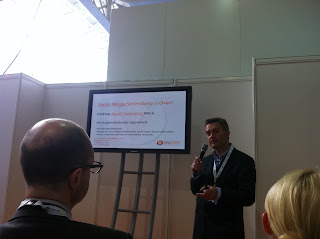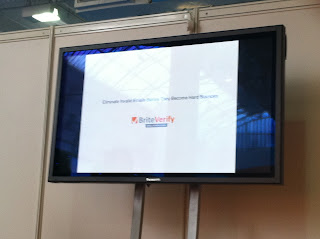So ad:tech is over for another year; did you attend? I did and I wanted to share a few thoughts on the day and the seminars I attended.
Overall I had a good day – I think as with anything a day at any of the marketing shows that happen throughout the year is about what you make of it, the seminars you attend, networking you do and companies you speak to. I attended with 2 colleagues and after having an initial coffee in the networking area, they went off to attend the meetings they had booked and I ventured to the seminar area to hear the first lecture of the day on social media run by a company called Viapoint entitled ‘ Social Media – The no hype guide to practices that work’.

In this half an hour seminar, some interesting points arose in regards to social commerce being the application of social media and looking at the ‘long game’ of this channel rather than a short term play as well as increasing customer value and relationships long term and building communities with advocates. I think a lot of companies expect to see an immediate ROI from social media but this should not be the main aim in the short term. From my point of view and from the discussion in this seminar, it is definitely prudent to think of this channel as a customer relations point and to build the relationships; use it to find out what they want, update them on the company and products and most importantly, address their concerns promptly through the channel. The presentation also listed an interesting look at participation groups in social media and the different levels of activity:
- In actives
- Spectators
- Joiners
- Collectors
- Critics
- Creators - bloggers
The speaker mentioned finding out what’s driving people to the social networks and what are they doing when they get there as well as looking at principal of 'network weaving' - knowing your network and then knitting your network together. He also mentioned the term ‘Memetics’; looking at why people follow other people – in essence, social networking is just human nature applied on the internet and the typical realms of psychology can basically be applied and adapted to study the medium. Looking at the behavior of people provides you with information about the consumers you are targeting on social networks, how they behave and why so that you can then target your strategy around this information and get the most from your social efforts.
Two other interesting stats where also mentioned that I noted down:
- Online engagement down 19% h1 2011 (UK)
- Click through banner ads decreasing - 30% p.a. (av0.05%)
In regards to the banner advertising statistic, I have long been an advocate of using this medium for brand awareness rather than as a solid way to drive traffic to a website and I think this statistic just proves the point further.
As an added point, Viapoint also used this opportunity to advertise a free social commerce planning session with them when you quote adtech. They didn’t however use this seminar time to pitch their company aggressively which I found was a positive point and something which some companies do too much; I feel these seminars are for learning not for pitching (fine to put your logo on every page and introduce the company on one slide at the beginning but don’t take up to much of the limited ½ hour slot with a sales pitch; if we want to know more about your company we will come and visit your stand or speak to you when the presentation is over!) To take advantage of this offer you can call 08453193797 – the offer is only valid until 30.11.2011.
Visiting the exhibitors and seeing who was there
I took the opportunity after this first seminar to circulate around the hall and see the exhibitors who were in attendance. I did feel this year that there weren’t so many, although shows earlier in the year such as Internet world and Marketing Week were huge, especially in comparison. I also felt that the range of different exhibitors was not as big as it usually is and had an enormous focus on agencies and, lead generation and reporting – which although is good, I didn’t feel that mobile, social media and email marketing for example were represented as much as they had been at other shows where more of a range was present, although of the companies that were there, these were the ones I did seek out. Regardless, I had a wonderful time meeting up with contacts old and new throughout the day and speaking to companies such as Emailvision, Pure360 and the wonderful folks at the DMA among many others. As you can tell my main interest is, and always has been email marketing and I relish the opportunity to meet with suppliers and see updates to their systems as well as discuss the industry and current trends with them.
A sales pitch before lunch…..
I also met with a former colleague for the next seminar on my list before heading out to have a good catch up over lunch at Pizza Express; conveniently attached to the venue. The pizzas there are always good but I was astounded at the lack of good service; I know it must’ve been a busy day for them but I have never in my life been to a restaurant that when it comes time to pay the bill, the credit card machine is just left on the table and the waiter wanders off! I was very surprised to say the least and definitely did not leave a tip!
The seminar that we attended just before this experience was about my favourite topic - Email Marketing. The seminar was being run by Stongmail and was entitled ‘Boost email marketing performance by 600% with lifecycle marketing’
Unfortunately, this seminar included quite a few slides of sales pitch – not only at the start of the presentation but throughout! They covered not only who they are, but went onto discuss a long list of their customers are at both the beginning and then at end of the presentation as well as how their technology can help you do lifecycle marketing – personally, I don’t find this appropriate in this setting; there is a time and a place and this was not it – in fact it succeeded in putting me off rather than the probable intention of drawing me in to their product. In such a short seminar time slot we want to pick up some tips and knowledge as the main aim, not to be sold a product; we can visit an exhibitor stand for that purpose!
They did however (in between talking about themselves) pick up on some key points of customer lifecycle marketing and having the ability to reach the right person with the right message at the right time through email marketing automation – something I am very keen on and always strive towards for the companies I work for. In my experience this can only increase results and makes your job as a marketer slightly easier; especially when using technology that can facilitate this including using dynamic content to product the personalised message based on your information on the individual consumer found in your database and the groups they fall into.
The gentleman leading the seminar went on to discuss looking at how you acquire people, build trust, engage and nurture. Then how you drive conversion, drive repeat conversion and loyalty as well as re-engage lapsed customers and generate advocacy with referral programs for example. In some statistics he quoted, a survey by e-marketer found that nearly 47% companies have already adapted a lifecycle marketing programme and 58% that haven't are planning to in next 24 months. A report entitled 'European email marketing’ produced in February 2011 also found that only 25% of marketers segment on past purchase behavior. Such a shame when this is your most valuable data, and in ,my opinion, increased targeting in this way and throughout the lifecycle is well worth the investment in time and technology! Don’t forget that customers are constantly bombarded with different marketing messages and have become a lot savvier over the years and now demand greater relevance for their attention and time.
The main benefits of using customer lifestyle marketing quoted included increased subscriber engagement an increase in campaign performance and of course, an increased in customer satisfaction. Putting yourself in the customer’s shoes when you are running a marketing campaign is important – would you be interested in the product? Is it relevant to where you are at in your lifecycle with the company? It is also important to remember to join on and offline marketing; as a consumer, we don't think about the channel we are being spoken to on - all we care about is the brand as a whole. Keeping a consistent message across, email, phone, direct mail, call centre, TV etc is important to present a single view of the company regardless of where the consumer is interacting with you or seeing you - they want to see it purely as the brand, not the channel through which they are engaging.
I think that another seminar that I caught halfway through also built on this point well. This one was about discovering the non obvious and was being presented by 02mc. They used the following example of how to use real time data and the right segments to send the right messages to consumers:
Day 1. Customer sees an email from you, visits the site, but doesn’t purchase.
Day 2. Customer sees one of your display advertising banners showing the same product, visits your site but still doesn't purchase.
Day 3. The customer see’s a Google ad from your site about the product, visits the site and makes the purchase.
But then on Day 4, they receive another email that has been generated automatically as a result of their non-purchase from the original communication you sent on day one with a discount for that product - but the customer did buy the product the previous day! How annoyed would you feel as the consumer? And all it would’ve taken was an extra query in the database to join up the customers data and check for a purchase after that first communication to stop this aggravation and miscommunication.
Their main point was that it is easy to miss something you are not looking for. Look out for the non obvious and ensure you use real time data and the right segments to send the right messages.
A buzzing brain full of mobile strategy!
At 3.50 I attend a seminar on Mobile marketing run by DMG and let’s just say it was not what I thought it was going to be! He began by listing all the things he wasn’t going to talk about (all the things I thought I was there to listen to!) and proceeded into a seminar about some really in depth mobile marketing and strategy – which was actually really interesting and gave more points than I thought I would take away from such a short time!
To start with, we were told some interesting statistics about the mobile industry in the UK:
- ROI - usage and understanding who Is using what devices
- 42% UK Smartphone penetration in UK (21m)
- Tablets have a 4% penetration in uk (2m) to grow by 2015 to 35% penetration (17m)
- 21.8m people using mobile web every month
- 43% of mobile users use apps
- 79% of Google’s advertisers around the world do not have a mobile optimised website
The focus of the presentation was then on mobile strategy and integrating mobile so that it is not a standalone platform and how people viewing content through this medium want 5 minute snacks - don't just port your website onto mobile – there will be far too much content. Think about what people will want to consumer from you in this short amount of time while they are on the move and work with this information to build a reduced down, informative and relevant mobile site. Objectives should be set in regards to what you want to achieve and the customer journey should be thought about – use mobile to remove barriers on customer journey and meet customer needs. It is also important to think about the technology behind people viewing your content on a mobile and how you can improve this (e.g. the current OS being used and upgrades to this and how it affects you or viewing on a new platform such as a tablet or the possibility that kindle will introduce this feature into their product). Another interesting fact was that Google just announced that mobile optimised sites will factor into landing page quality and perform better in Adwords. There is a definite need for a mobile strategy to be agile and change as the market changes; which is very regularly! It is not necessarily possible to have a mobile strategy set in stone for 12-18 months ahead; focus instead on the next couple of months and keep updating as you go.
It was interesting to note the 4 main reasons that pick up a phone and go online; “ I'm bored now”, “I'm repetitive now”, “It's urgent now” (for example for location use and looking at Google maps, or finding a restaurant) or for mobile social media use. Mobile is dual screen - I.e. people can be watching TV at the same time and having conversations on the internet through their phones about TV programmes, or watching TV and playing games etc at the same time. Mobile is now also used in store with people using phones to aid their shopping experiences by checking prices, checking with friends what they think etc.
End of another year at ad:tech
After leaving the last seminar with my head buzzing with mobile strategy, I moved on to end the day by attending the final Email Marketing seminar of the exhibition presented by Briteverify who discussed how to eliminate invalid emails before they become hard bounces in your database. I felt particularly sorry for this speaker who in the end finished the presentation in less than 15 minutes; not surprising as there was a grand total of 5 people including myself listening to him speaking.

In this short time, he discussed the meaning of a valid email address (an address that exists and will not hard bounce upon delivery) and a client case study showing how they cleaned up their data and data collection process after spending $1 to verify 100 email addresses (€10/1000) with his company through real time email verification on sign up with an error message shown to the consumer if the email they entered was invalid (plugged right into the form). He also briefly discussed how invalid emails affect deliverability, but what I didn’t agree with was a comment he made about his company and this technology directly affecting inbox placement. Yes removing invalid emails from your database is always going to help deliverability as you are not having these emails clogging up your sends and reported invalid email errors, but a direct relationship to inbox placement? Let’s just say I don’t think I have ever raised my eyebrows so high!
I think @rossnichols asked a good summing up question for the day through Twitter: “If you were to sum up the topics/insights from #adt4ech in 5 terms what would they be?” My response to this tweet and was to note mobile applications and strategy, ESPs, search and social – although as I have mentioned earlier in this post, I don’t feel the presence was there in force as it has been previously at other shows throughout the year and in previous ad:tech’s I have attended…
What did you think? Let me know!

















